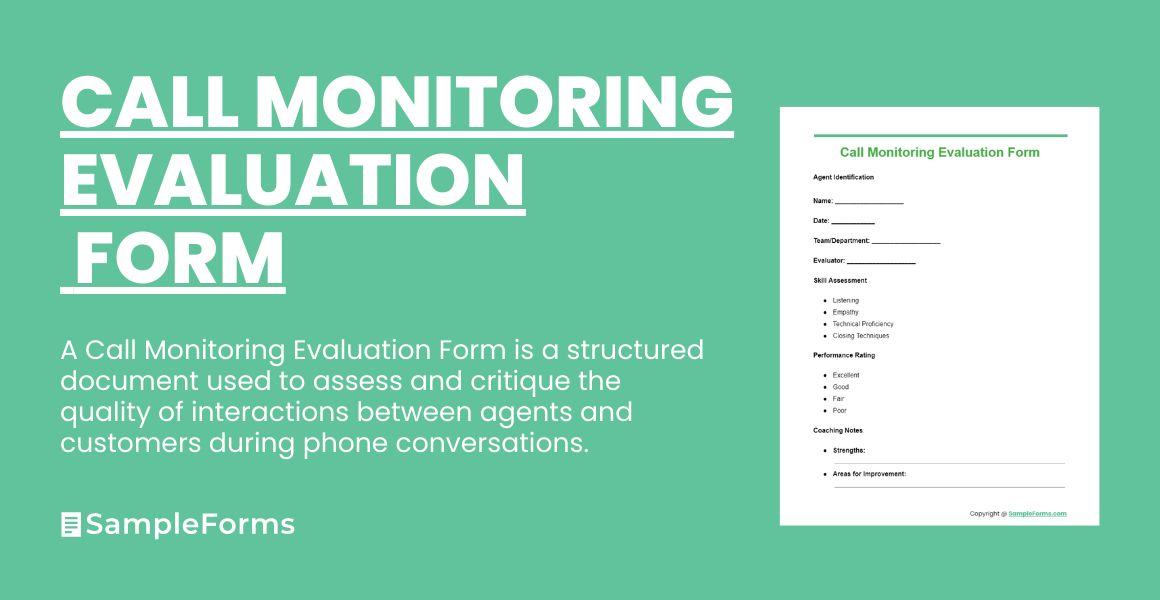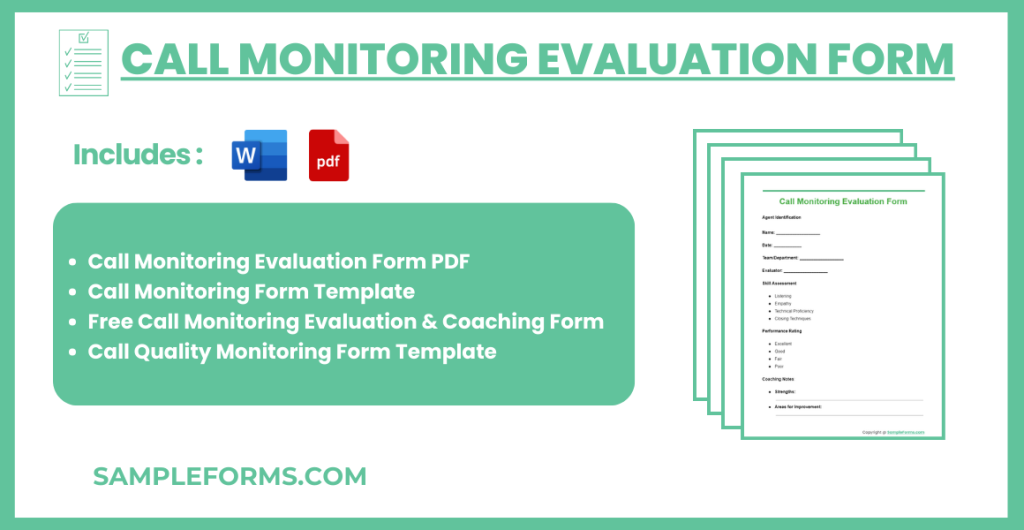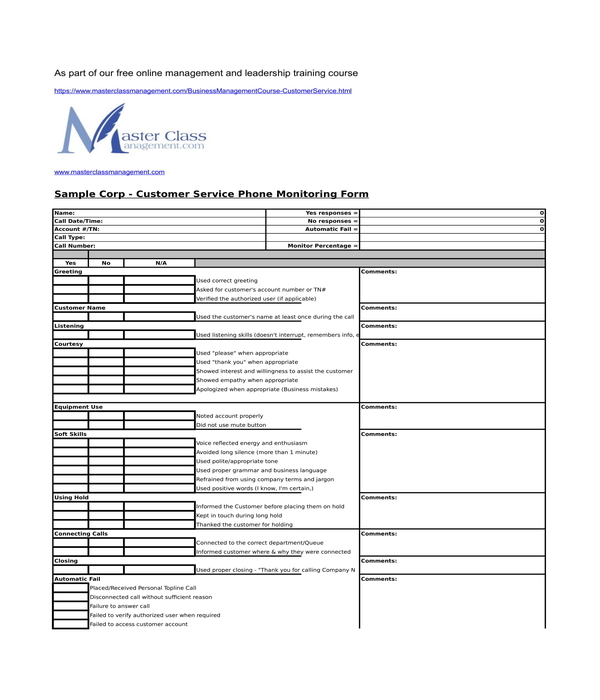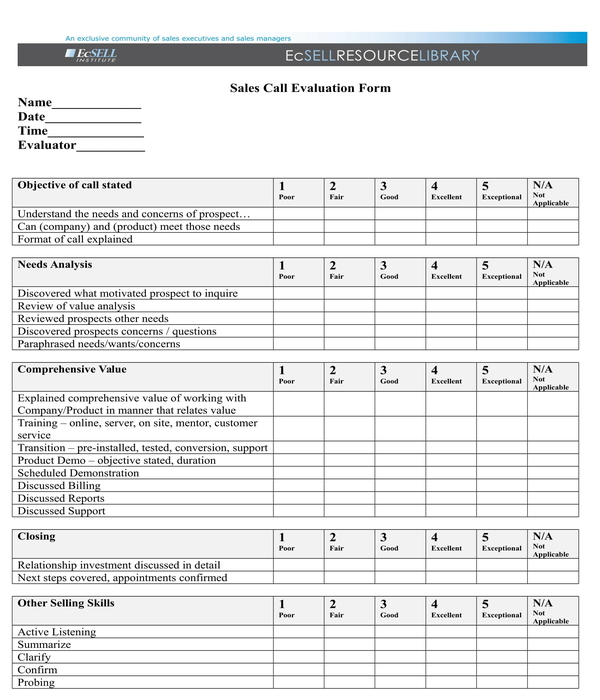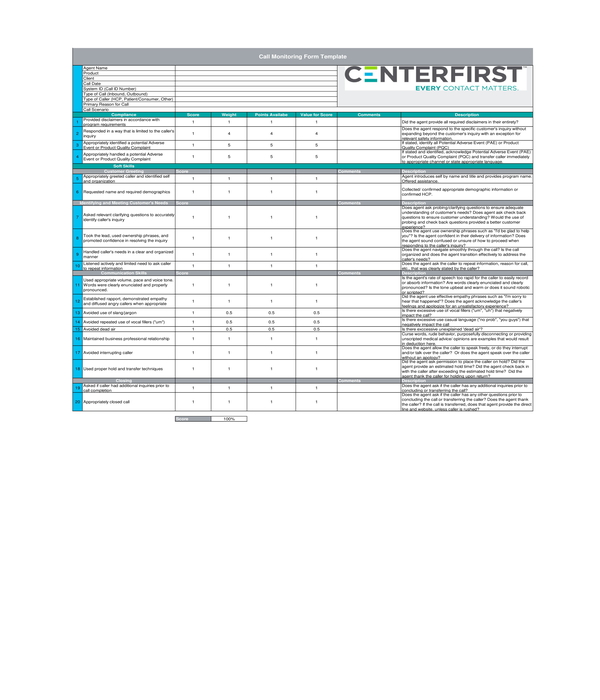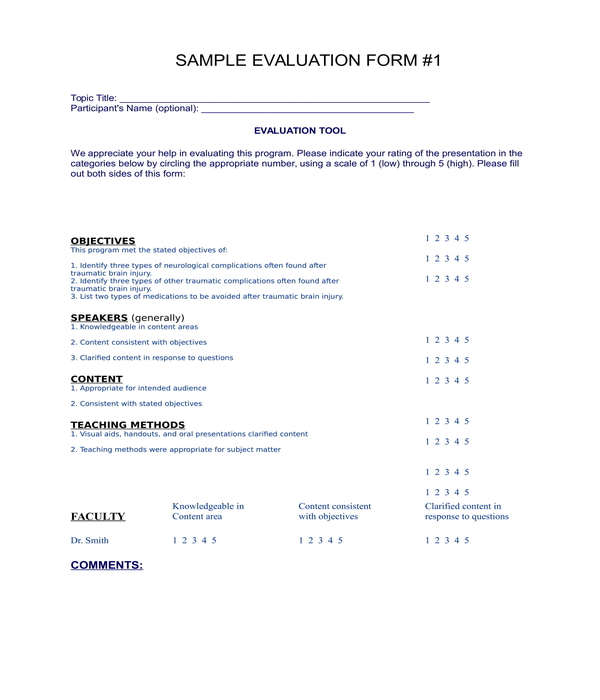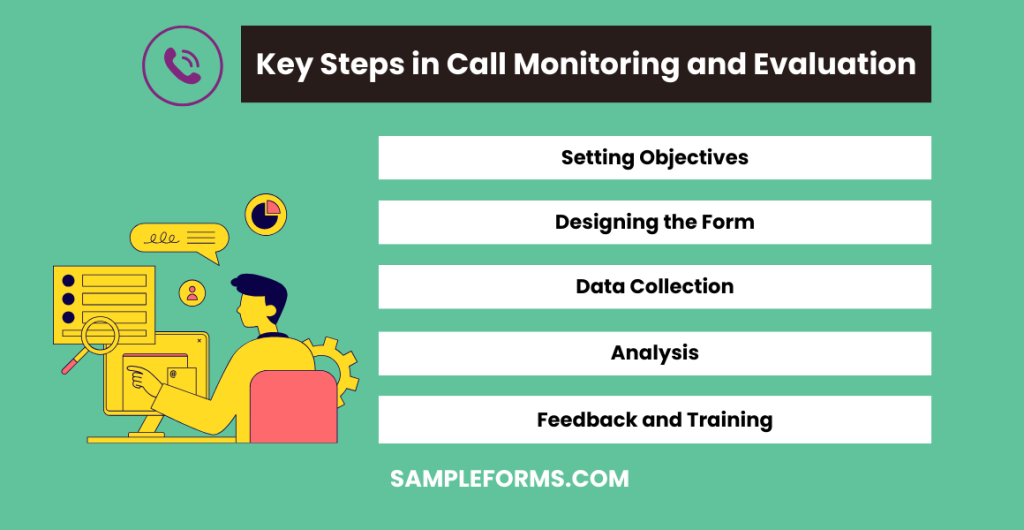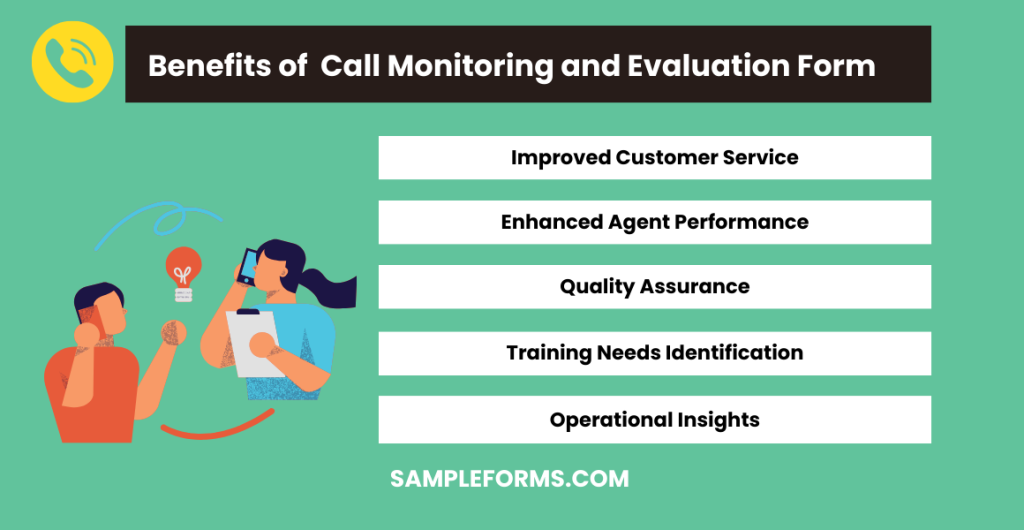Dive into the essentials of enhancing workplace efficiency with our Call Monitoring Evaluation Form guide. This comprehensive resource is designed to bridge the gap between performance expectations and actual outcomes. Whether you’re looking to refine your evaluation techniques or develop a more robust Employee Evaluation Form, our guide offers invaluable insights. Packed with practical examples, it’s the ultimate tool for supervisors committed to fostering growth and excellence within their teams.
Download Call Monitoring Evaluation Form Bundle
What is Call Monitoring Evaluation Form?
A Call Monitoring Evaluation Form is a structured tool used by businesses to assess and improve the quality of interactions between customer service representatives and customers. It evaluates various aspects of the call, such as communication skills, problem-solving abilities, adherence to company protocols, and overall customer satisfaction. This form is pivotal for providing constructive feedback to employees, thereby enhancing their performance and the overall customer experience.
Call Monitoring Evaluation Format
Section 1: Introduction
- Begin with the agent’s basic information including name, date, and the call being evaluated.
Section 2: Evaluation Criteria
- List key areas such as greeting, call handling, professionalism, product knowledge, and resolution skills. Use a checklist format for ease of evaluation.
Section 3: Scoring
- Implement a simple scoring system (e.g., 1-5 or Excellent to Needs Improvement) for each criterion.
Section 4: Comments and Feedback
- Provide space for detailed comments on the agent’s performance, highlighting strengths and areas for improvement.
Section 5: Overall Evaluation
- Summarize the overall performance with a final score or rating, and suggest next steps or areas for coaching.
Call Monitoring Evaluation Form PDF
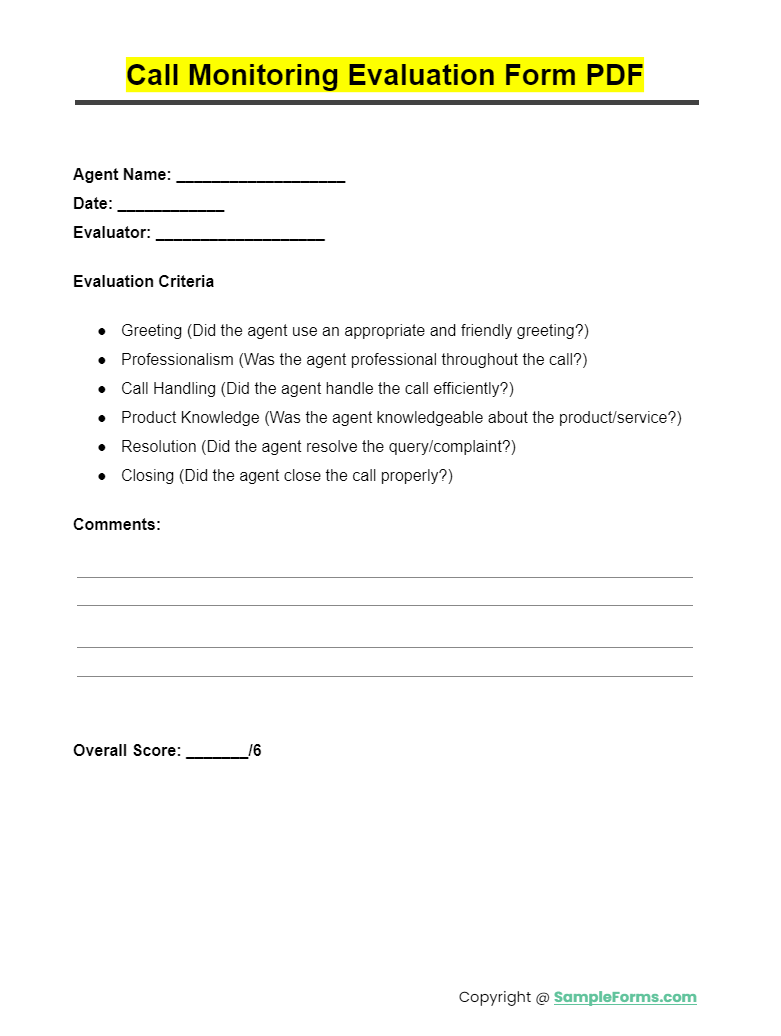
Explore a comprehensive PDF guide for Call Monitoring, integrating Self Evaluation Form techniques to enhance personal and team performance in customer interactions.
Call Monitoring Form Template
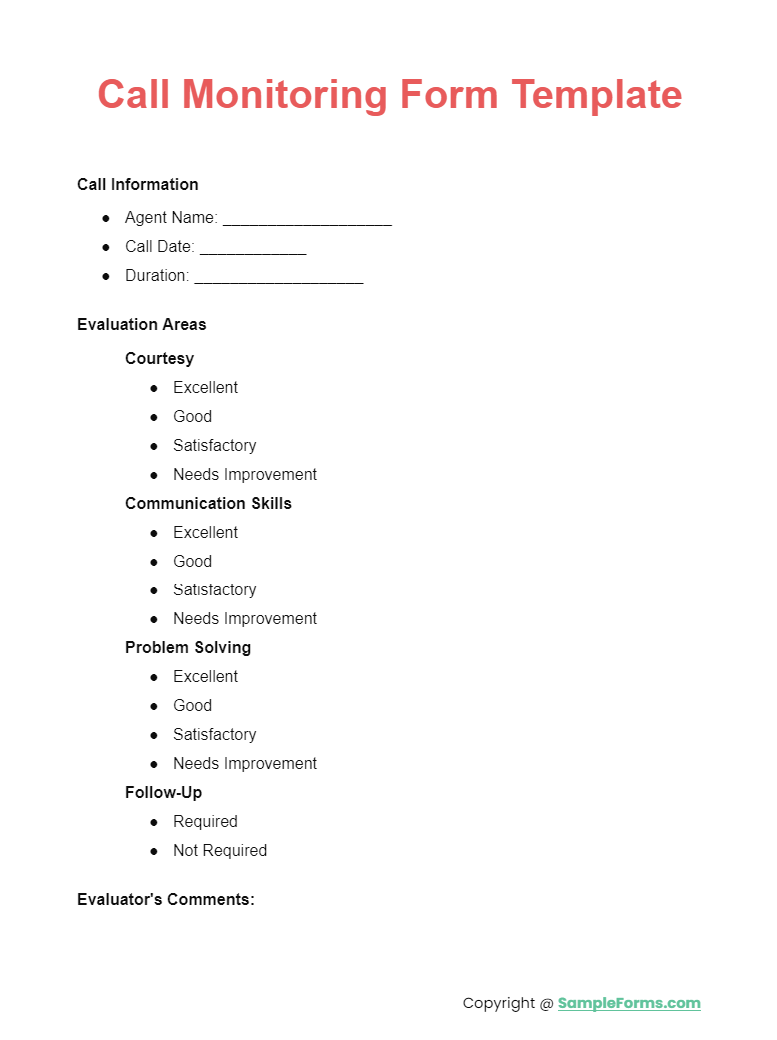
This template serves as the foundation for systematic call assessments, incorporating Training Evaluation Form principles to elevate customer service training programs.
Free Call Monitoring Evaluation and Coaching Form
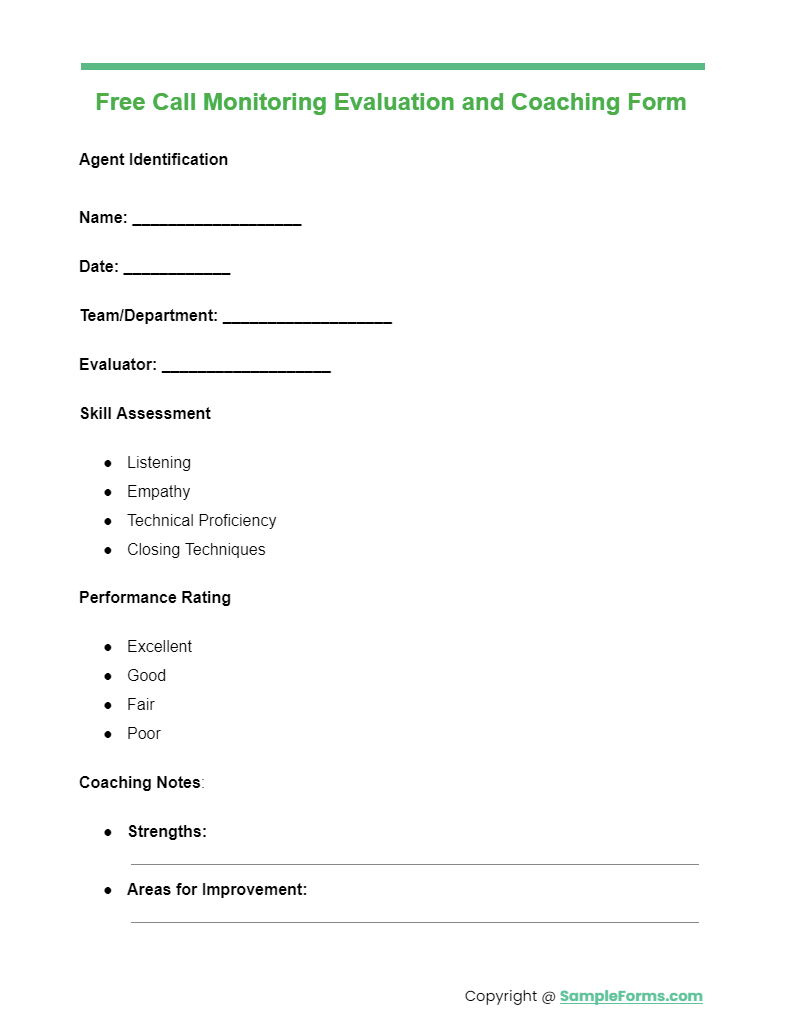
Leverage our free form to intertwine Employee Self Evaluation Form practices with call monitoring, promoting self-improvement and coaching opportunities for agents.
Call Quality Monitoring Form Template
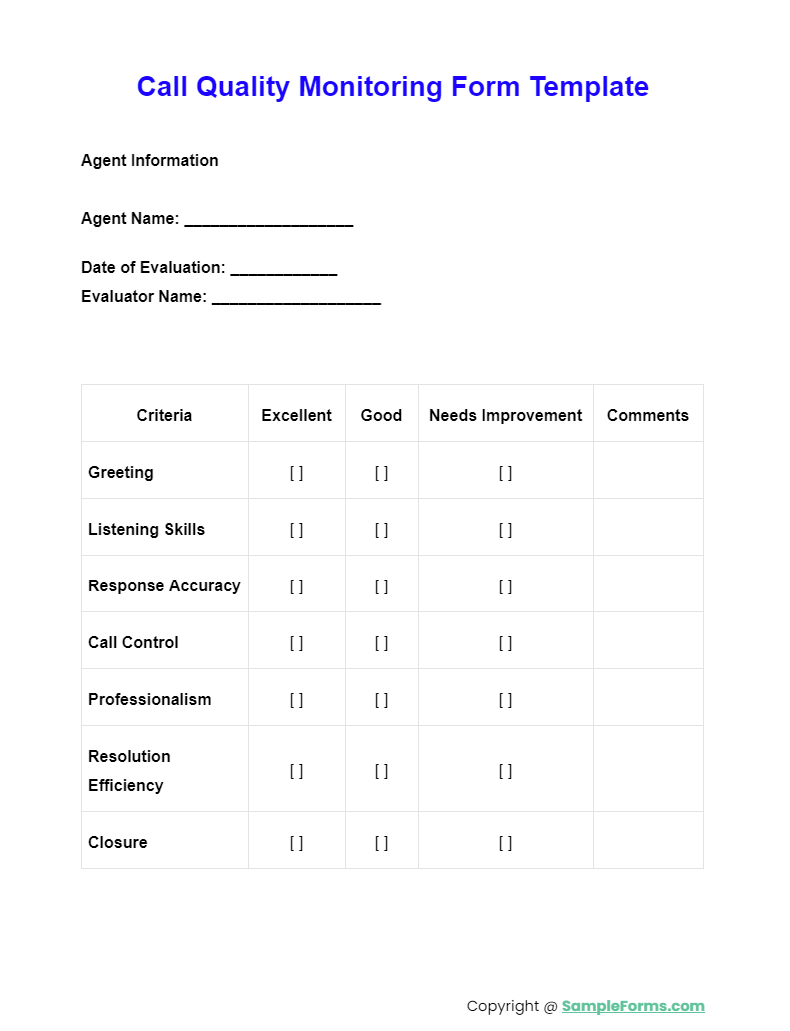
Adopt this template to refine call quality analysis through Peer Evaluation Form methodologies, fostering a collaborative environment for feedback and improvement.
Each guide is optimized for “Call Monitoring Evaluation Form,” incorporating the essentials of Employee Performance Evaluation Form, Interview Evaluation Form, Presentation Evaluation Form, and Food Sensory Evaluation Form to cover a broad spectrum of evaluation needs within the customer service domain, ensuring a well-rounded approach to performance and quality assessment.
More Call Monitoring Evaluation Form Samples
Phone Monitoring Form
Best Practice Sales Call Evaluation Form
Call Monitoring Form
Sample Evaluation Forms
What are Key Steps in Call Monitoring and Evaluation?
- Setting Objectives: Establish clear goals for what the monitoring aims to achieve, similar to defining success criteria in a project.
- Designing the Form: Create a comprehensive evaluation form that covers all necessary aspects of the call, ensuring a holistic review.
- Data Collection: Record or listen to calls within the set parameters to gather data for evaluation.
- Analysis: Review the collected data against the set objectives to identify trends, strengths, and areas for improvement.
- Feedback and Training: Provide constructive feedback to agents and implement targeted training programs based on the analysis.
Sample Items to Include in a Call Monitoring Evaluation Form
Greeting: This tackles on the introduction and the action of giving recognition to the caller. This often sets the mood for the duration of the call.
- The agent follows the script of the greeting.
- If the call was transferred, the agent adjusted to their greeting correspondingly.
- The agent introduced himself to the client.
- The agent made mention of their company name.
- The agent informed the client that the call is being recorded.
- Name of the client was asked by the agent.
- The agent expressed their gratitude to the customer for calling.
- Assistance was offered to the client by the agent.
Verification of Account: This portion is the manner or the method of confirming that the caller has a new or existing account that the agent can assist in.
- The agent confirmed the account of the client using the suitable information.
- The agent correctly accessed the account of the customer with the information that has been given.
- If the call was transferred, the agent adjusted their verification of the account questions correspondingly. Alos check our Reference Check Phone Script Form
Confirmation of Contact Information: One importance behind contact information confirmation is to make sure that the caller is the real person. Asking the caller information that only the real person does will eliminate any doubt of identity fraud.
- The agent requested for the client to spell their name.
- The agent inquired regarding the caller’s company name.
- The agent inquired for the telephone number of the caller.
- The agent queried for the caller’s email address.
Ability to Solve Problems: This part evaluates the agent’s ability in handling certain, and oftentimes stressful, issues that the caller is needing assistance with. Also Check our Telephone Reference Check Form.
- The agent expressed their apologies regarding the issue, trouble, or charges correlated with the problem.
- The problem experienced by the client has taken ownership by the agent.
- The agent asked for the error code messages from the caller.
- The correct resources are used by the agent to address the client’s issues.
- The most suitable solution was provided by the agent.
- The agent gave the client an appropriate estimated timeline to resolve their issue.
- Relevant supporting documentation to aid in resolving the issue was provided by the agent to the customer.
- The agent supplied the client with a reference number once resolving their issue.
- Confirmation that the issue was resolved was provided by the agent.
- The caller’s concern/s were addressed in a satisfactory manner.
How do You Evaluate a Call?
Evaluating a call involves a detailed analysis of the interaction between a customer service representative and a customer. This process starts with preparing a Supplier Evaluation Form (DOC) to assess the quality of service provided. Here are the steps involved:
- Preparation: Before the call, ensure all necessary tools and forms are ready, including a Speech Evaluation Form for assessing communication skills.
- Listening: Pay close attention to the call, noting key points related to problem-solving, empathy, and adherence to protocols.
- Assessment: Utilize a structured form, similar to a Nurse Evaluation Form, to evaluate specific criteria such as tone, clarity, and customer satisfaction.
- Feedback: Provide constructive feedback based on the evaluation to help improve future interactions.
What Criteria should be Included in a Call Monitoring Form?
Incorporating the right criteria is crucial for an effective Call Monitoring Form. This process is akin to filling out a Debate Evaluation Form, where specific skills and attributes are assessed. Essential steps include:
- Greeting and Introduction: Assess how well the agent introduces themselves and the company.
- Understanding and Clarity: Evaluate the agent’s ability to understand customer needs and provide clear solutions, reflecting principles found in an Internship Evaluation Form.
- Professionalism and Courtesy: Use criteria similar to those in a Food Evaluation Form to gauge the agent’s professionalism and manner.
- Resolution and Efficiency: Like a Proposal Evaluation Form, this step focuses on the agent’s ability to resolve issues efficiently and effectively.
- Closing: Assess how well the agent concludes the call, ensuring customer satisfaction and offering further assistance if needed.
How do you Evaluate your Performance after Every Call?
Evaluating your own performance after every call requires self-reflection and structured assessment, akin to completing a Course Evaluation Form. Steps include:
- Self-Reflection: Immediately after the call, reflect on the interaction, similar to how one would fill out a Teacher Evaluation Form.
- Checklist Review: Go through a personalized checklist that includes items you would find on a Mentor Evaluation Form to ensure all key aspects were covered.
- Customer Feedback: Consider any direct or indirect feedback received during the call as part of your self-assessment.
- Improvement Plan: Identify areas for improvement, akin to completing a Mentee Evaluation Form, and set specific goals for future interactions.
What are the 5 Criteria in Monitoring and Evaluation?
The five critical criteria for effective monitoring and evaluation in call monitoring encompass:
- Effectiveness: Analyze how effectively the call resolved the customer’s issue, mirroring the objective assessment of a Supplier Evaluation Form.
- Efficiency: Evaluate the timeliness of the resolution, similar to assessments conducted with a Functional Capacity Evaluation Form.
- Relevance: Determine how relevant the provided solutions were to the customer’s needs, akin to a Trainee Evaluation Form.
- Impact: Assess the long-term impact of the call on customer satisfaction and loyalty, reflecting deeper insights like those sought in a Basketball Evaluation Form.
- Sustainability: Consider the sustainability of the solution provided, ensuring it prevents future calls for the same issue, as one might evaluate in a Mentor Evaluation Form.
What is Quality Evaluation in Call Center?
Quality evaluation in a call center involves systematically reviewing and analyzing call interactions based on specific criteria to ensure high standards of customer service. This process is similar to conducting a thorough Seminar Evaluation Form review but focused on customer service interactions. The goal is to identify strengths, areas for improvement, and ensure that all customer interactions meet or exceed the company’s quality standards. This continuous improvement cycle helps in enhancing customer satisfaction, agent performance, and overall operational efficiency. Also Check our Speaker Evaluation Form.
What are Benefits of Using a Call Monitoring and Evaluation Form?
- Improved Customer Service: Identifies areas for improvement in customer interactions, leading to enhanced customer satisfaction.
- Enhanced Agent Performance: Offers specific feedback to agents, facilitating personal and professional development.
- Quality Assurance: Ensures consistency in call handling, adhering to the company’s standards of service.
- Training Needs Identification: Reveals common areas where agents require additional training or resources.
- Operational Insights: Provides valuable insights into operational efficiencies and customer service strategies, driving informed decision-making.
What is the Purpose of the Monitoring and Evaluation Plan?
The purpose is to ensure continual improvement and effectiveness, akin to using a Sensory Evaluation Form, by assessing performance against goals, identifying areas for enhancement, and implementing strategic changes.
Who can Perform Call Quality Monitoring?
Call quality monitoring can be performed by supervisors, quality assurance teams, or through peer review, similar to a Driver Evaluation Form, to ensure unbiased and comprehensive evaluations. Also Check our Resume Evaluation Form
What are the Key Steps in Monitoring and Evaluation?
Key steps include defining objectives (like a Workshop Evaluation Form), collecting data, analyzing results, reporting findings, and implementing improvements, ensuring a cycle of continuous performance enhancement.
What is the Main Reason for Monitoring and Evaluation?
The main reason is to verify that objectives are met and resources are used efficiently, paralleling the feedback loop of a Sales Evaluation Form, to drive strategic improvements and accountability.
How Many Calls should be Monitored in a Call Center?
The number varies but aiming for a statistically significant sample, akin to a Candidate Evaluation Form approach, ensures a comprehensive understanding of performance trends and agent training needs.
How Many Calls Should be Evaluated?
Ideally, enough calls should be evaluated to provide meaningful insights into agent performance and customer satisfaction, similar to the thoroughness required in a Customer Service Evaluation Form, to identify trends and training opportunities.
Related Posts
-
FREE 6+ Business Credit Checklist Forms in PDF
-
Employee Pay Increase Form
-
FREE 8+ Kitchen Evaluation Forms in PDF | MS Word
-
Customer Service Evaluation Form
-
FREE 15+ Grant Evaluation Forms in PDF | MS Word
-
FREE 14+ Volunteer Evaluation Forms in PDF
-
Mentee Evaluation Form
-
Speaker Evaluation Form
-
FREE 14+ Vehicle Evaluation Forms in PDF
-
FREE 14+ Trainee Evaluation Forms in MS Word | PDF
-
Resume Evaluation Form
-
FREE 14+ Retreat Evaluation Forms in PDF
-
Debate Evaluation Form
-
FREE 14+ Book Evaluation Forms in PDF | MS Word
-
Food Evaluation Form
